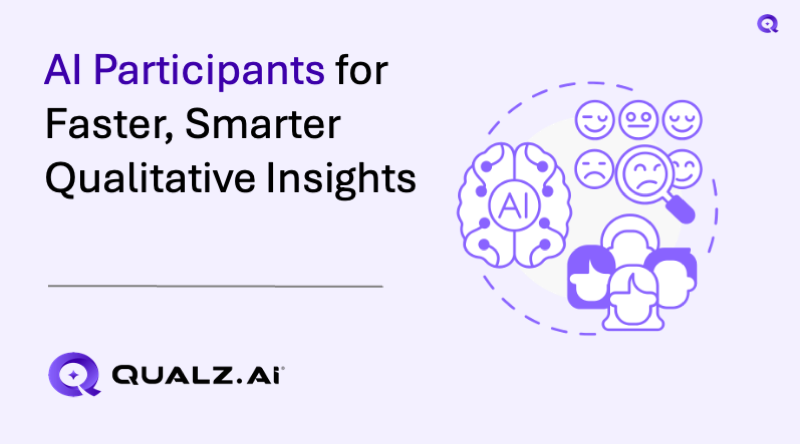Every research study begins with an idea—but turning that idea into insight depends on having the right participants.
Yet, this essential step often becomes a major bottleneck. Recruiting participants can slow timelines, stretch budgets, and limit the depth of insights.
Topics Covered
ToggleThe Pain of Traditional Participant Recruitment
You start with a solid research plan, only to hit a wall:
- Finding the right participants takes weeks.
- Scheduling is a constant struggle—with dropouts and no-shows.
- Incentives inflate costs, especially for niche groups.
- Sample diversity is difficult to achieve.
Even when recruitment is successful, there’s often uncertainty about whether the sample truly reflects the voices that matter. For researchers in academia, nonprofits, or solo practice, these hurdles can be overwhelming.
In a fast-moving world, traditional recruitment methods struggle to keep pace—delaying insights and decision-making.
What Are AI Participants?
AI Participants are synthetic, intelligent personas created to simulate real human responses in qualitative research. On platforms like Qualz.AI, researchers can define participant profiles by demographics, behaviors, or attitudes, then launch studies using these AI-generated respondents.
AI participants can:
- Engage in dynamic surveys or interviews
- Provide contextual, human-like responses
- Be tailored by language, tone, and persona
They’re not designed to replace human participants entirely—but to offer a scalable, on-demand alternative when speed, consistency, and accessibility are essential.
How AI Participants Solve the Biggest Research Bottlenecks
AI participants remove many of the logistical and financial hurdles that slow down qualitative research:
Instant Access
No waiting. Launch studies anytime with always-available AI respondents.
Lower Costs
Eliminate incentive budgets and recruitment agency fees—reducing costs.
Diverse Sampling
Simulate a wide range of personas instantly, including hard-to-reach or underrepresented groups.
Seamless Analysis
Pair with AI-driven analysis tools for automatic coding, categorization, and theme extraction.
Better Control
Test messaging or concepts in a consistent, bias-reduced environment.
Real-World Examples of AI Participants in Action
Market Research Agencies
Agencies simulate buyer personas for rapid A/B testing in brand perception studies. AI enables speed and scale without compromising insight (Deloitte Insights, 2023).
Academic Researchers
A behavioral economics researcher simulated stakeholder views across regions to refine interview guides before live testing—an approach gaining traction in social sciences (Nature Human Behaviour, 2022).
Nonprofits and NGOs
NGOs exploring service gaps in underserved areas use AI Participants to simulate diverse community voices when in-person research isn’t feasible (UN Global Pulse, 2021).
Things to Keep in Mind When Using AI Participants
While powerful, AI Participants aren’t perfect. Be aware of:
1. Simulation vs. Lived Experience
They mimic behavior but don’t experience life. Use with caution for emotional or trauma-based research.
2. Emotional Realism
AI lacks subtle emotional cues that real participants may naturally display.
3. Data Bias Risk
AI outputs are only as neutral as their training data. Critical review is essential.
4. Supplement, Not Replace
AI Participants excel at early-stage testing—but human validation remains key for publication-grade work.
Who Should Be Using AI Participants?
AI Participants are ideal for:
- Market researchers seeking fast feedback loops
- Academics working under time and funding constraints
- NGOs needing remote or multilingual respondent access
- Independent researchers conducting lean studies
When time, access, or cost is a barrier, AI Participants offer a flexible, scalable solution.
Want help integrating AI Participants into your workflow or classroom? Let us know, and we can tailor a demo or guide to your research goals.
Considering AI Participants?
Here’s What You Can Try with Qualz.AI
If you’re exploring new methods, Qualz.AI offers a low-barrier way to start. Try:
- Creating a participant persona aligned with your study
- Launching a pilot interview to test scripts
- Uploading a past survey to compare AI Participant feedback
- Reviewing the built-in analysis tools for auto-generated insights
Already using AI-Moderated Interviews? Pairing them with AI Participants creates a full-stack research workflow.
Conclusion
AI Participants aren’t a universal fix—but they are a meaningful shift in how researchers approach qualitative insight gathering. By removing bottlenecks around time, access, and scale, they unlock new possibilities for iterative, efficient, and adaptive research.
Whether you’re exploring, testing, or scaling, this approach offers an open door to rethink what’s possible in qualitative research today.
